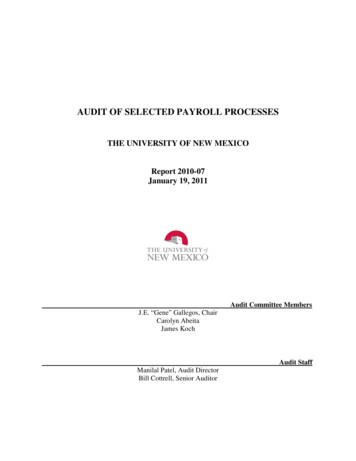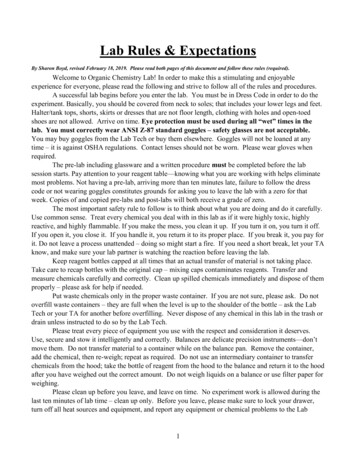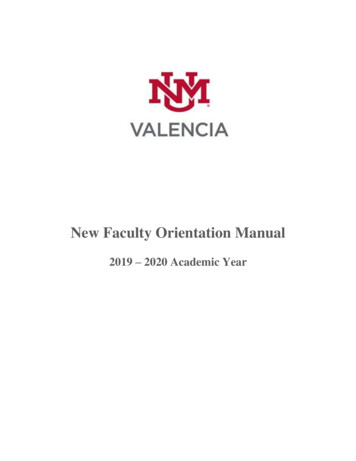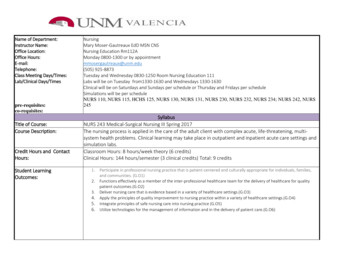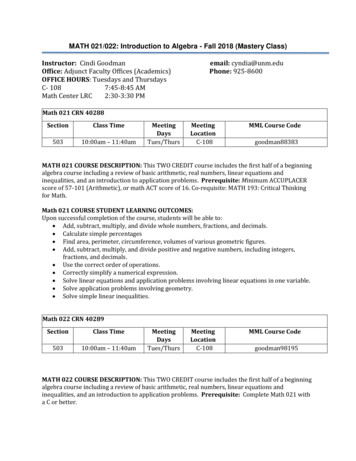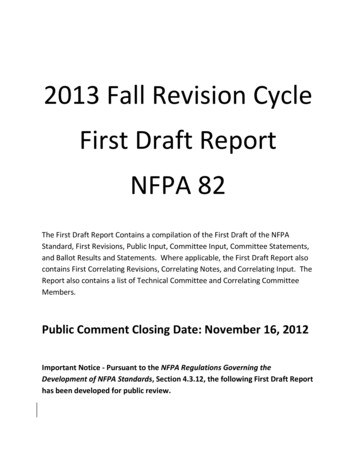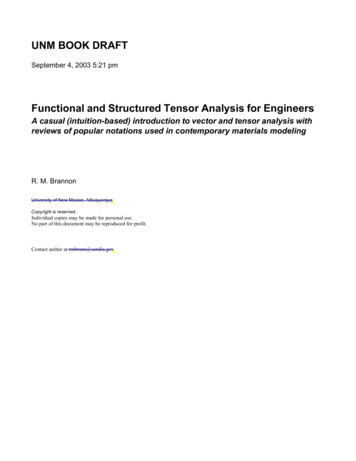
Transcription
UNM BOOK DRAFTSeptember 4, 2003 5:21 pmFunctional and Structured Tensor Analysis for EngineersA casual (intuition-based) introduction to vector and tensor analysis withreviews of popular notations used in contemporary materials modelingR. M. BrannonUniversity of New Mexico, AlbuquerqueCopyright is reserved.Individual copies may be made for personal use.No part of this document may be reproduced for profit.Contact author at rmbrann@sandia.gov
N O T E: W h e n u s i n g A d o b e ’s “ a c r o b a t r e a d e r ” t o v i e w t h i sd o c u m e n t , t h e pa g e n u m b e r s i n a c r o b a t w i l l n o t c o i n c i d ew it h t h e pa g e n u m b e r s s h o w n a t t h e b o t t o m o f e a c h pa g eo f t h i s d o cu m e n t .N o t e t o d r a f t r e a d e r s : T h e m o s t u s e f u l t e x t b oo k s a r et h e o n e s w i t h f a n t a s t i c i n d e x e s . T he b o o k ’s i n d e x i srather new and still under construction.It would really help if you all could send me a notewhenever you discover that an important entry is missing from this index. I’ll be sure to add it.T h i s w o r k i s a c o m m u n i t y e ff o r t . L e t ’s t r y t o m a k e t h i sdocument helpful to others.
FUNCTIONAL AND STRUCTURED TENSORANALYSIS FOR ENGINEERSA casual (intuition-based) introduction to vectorand tensor analysis with reviews of popularnotations used in contemporary materialsmodelingRebecca M. Brannon††Universityof New Mexico Adjunct professorrmbrann@sandia.govAbstractElementary vector and tensor analysis concepts are reviewed in a manner thatproves useful for higher-order tensor analysis of anisotropic media. In additionto reviewing basic matrix and vector analysis, the concept of a tensor is covered by reviewing and contrasting numerous different definition one might seein the literature for the term “tensor.” Basic vector and tensor operations areprovided, as well as some lesser-known operations that are useful in materialsmodeling. Considerable space is devoted to “philosophical” discussions aboutrelative merits of the many (often conflicting) tensor notation systems in popular use.
ii
AcknowledgmentsAn indeterminately large (but, of course, countable) set of people who have offeredadvice, encouragement, and fantastic suggestions throughout the years that I’ve spentwriting this document. I say years because the seeds for this document were sown back in1986, when I was a co-op student at Los Alamos National Laboratories, and I made themistake of asking my supervisor, Norm Johnson, “what’s a tensor?” His reply? “read theappendix of R.B. “Bob” Bird’s book, Dynamics of Polymeric Liquids. I did — and gothooked. Bird’s appendix (which has nothing to do with polymers) is an outstanding andsuccinct summary of vector and tensor analysis. Reading it motivated me, as an undergraduate, to take my first graduate level continuum mechanics class from Dr. H.L. “Buck”Schreyer at the University of New Mexico. Buck Schreyer used multiple underlinesbeneath symbols as a teaching aid to help his students keep track of the different kinds ofstrange new objects (tensors) appearing in his lectures, and I have adopted his notation inthis document. Later taking Buck’s beginning and advanced finite element classes furtherimproved my command of matrix analysis and partial differential equations. Buck’s teaching pace was fast, so we all struggled to keep up. Buck was careful to explain that hewould often cover esoteric subjects principally to enable us to effectively read the literature, though sometimes merely to give us a different perspective on what we had alreadylearned. Buck armed us with a slew of neat tricks or fascinating insights that were rarelyseen in any publications. I often found myself “secretly” using Buck’s tips in my ownwork, and then struggling to figure out how to explain how I was able to come up withthese “miracle instant answers” — the effort to reproduce my results using conventional(better known) techniques helped me learn better how to communicate difficult conceptsto a broader audience. While taking Buck’s continuum mechanics course, I simultaneously learned variational mechanics from Fred Ju (also at UNM), which was fortunatetiming because Dr. Ju’s refreshing and careful teaching style forced me to make enlightening connections between his class and Schreyer’s class. Taking thermodynamics from A.Razanni (UNM) helped me improve my understanding of partial derivatives and theirapplications (furthermore, my interactions with Buck Schreyer helped me figure out howgas thermodynamics equations generalized to the solid mechanics arena). Following myundergraduate experiences at UNM, I was fortunate to learn advanced applications of continuum mechanics from my Ph.D advisor, Prof. Walt Drugan (U. Wisconsin), who introduced me to even more (often completely new) viewpoints to add to my tensor analysistoolbelt. While at Wisconsin, I took an elasticity course from Prof. Chen, who was enamoured of doing all proofs entirely in curvilinear notation, so I was forced to improve myabilities in this area (curvilinear analysis is not covered in this book, but it may be found ina separate publication, Ref. [6]. A slightly different spin on curvilinear analysis camewhen I took Arthur Lodge’s “Elastic Liquids” class. My third continuum mechanicscourse, this time taught by Millard Johnson (U. Wisc), introduced me to the usefulness of“Rossetta stone” type derivations of classic theorems, done using multiple notations tomake them clear to every reader. It was here where I conceded that no single notation issuperior, and I had better become darn good at them all. At Wisconsin, I took a class onGreens functions and boundary value problems from the noted mathematician R. Dickey,who really drove home the importance of projection operations in physical applications,and instilled in me the irresistible habit of examining operators for their properties andiii
classifying them as outlined in our class textbook [12]; it was Dickey who finally got meinto the habit of looking for analogies between seemingly unrelated operators and sets sothat my strong knowledge. Dickey himself got sideswiped by this habit when I solved oneof his exam questions by doing it using a technique that I had learned in Buck Schreyer’scontinuum mechanics class and which I realized would also work on the exam question bymerely re-interpreting the vector dot product as the inner product that applies for continuous functions. As I walked into my Ph.D. defense, I warned Dickey (who was on my committee) that my thesis was really just a giant application of the projection theorem, and hereplied “most are, but you are distinguished by recognizing the fact!” Even though neitherthis book nor very many of my other publications (aside from Ref. [6], of course) employcurvilinear notation, my exposure to it has been invaluable to lend insight to the relationship between so-called “convected coordinates” and “unconvected reference spaces” oftenused in materials modeling. Having gotten my first exposure to tensor analysis from reading Bird’s polymer book, I naturally felt compelled to take his macromolecular fluiddynamics course at U. Wisc, which solidified several concepts further. Bird’s course wasimmediately followed by an applied analysis course, taught by , where more correct“mathematician’s” viewpoints on tensor analysis were drilled into me (the textbook forthis course [17] is outstanding, and don’t be swayed by the fact that “chemical engineering” is part of its title — the book applies to any field of physics). These and numerousother academic mentors I’ve had throughout my career have given me a wonderfully balanced set of analysis tools, and I wish I could thank them enough.For the longest time, this “Acknowledgement” section said only “Acknowledgementsto be added. Stay tuned.” Assigning such low priority to the acknowledgements sectionwas a gross tactical error on my part. When my colleagues offered assistance and suggestions in the earliest days of error-ridden rough drafts of this book, I thought to myself “Ishould thank them in my acknowledgements section.” A few years later, I sit here trying torecall the droves of early reviewers. I remember contributions from Glenn Randers-Pherson because his advice for one of my other publications proved to be incredibly helpful,and he did the same for this more elementary document as well. A few folks (Mark Christen, Allen Robinson, Stewart Silling, Paul Taylor, Tim Trucano) in my former departmentat Sandia National Labs also came forward with suggestions or helpful discussions thatwere incorporated into this book. While in my new department at Sandia National Laboratories, I continued to gain new insight, especially from Dan Segalman and Bill Scherzinger.Part of what has driven me to continue to improve this document has been the numerous encouraging remarks (approximately one per week) that I have received fromresearchers and students all over the world who have stumbled upon the pdf draft versionof this document that I originally wrote as a student’s guide when I taught ContinuumMechanics at UNM. I don’t recall the names of people who sent me encouraging words inthe early days, but some recent folks are Ricardo Colorado, Vince Owens, Dave Doolinand Mr. Jan Cox. Jan was especially inspiring because he was so enthusiastic about thiswork that he spent an entire afternoon disscussing it with me after a business trip I made tohis home city, Oakland CA. Even some professors [such as Lynn Bennethum (U. Colorado), Ron Smelser (U. Idaho), Tom Scarpas (TU Delft), Sanjay Arwad (JHU), KasparWilliam (U. Colorado), Walt Gerstle (U. New Mexico)] have told me that they haveivCopyright is reserved. Individual copies may be made for personal use. No part of this document may be reproduced for profit.
directed their own students to the web version of this document as supplemental reading.In Sept. 2002, Bob Cain sent me an email asking about printing issues of the webdraft; his email signature had the Einstein quote that you now see heading Chapter 1 ofthis document. After getting his permission to also use that quote in my own document, Iwas inspired to begin every chapter with an ice-breaker quote from my personal collection.I still need to recognize the many folks who have senthelpful emails over the last year. Stay tuned.v
ContentsAcknowledgments .Preface.Introduction.STRUCTURES and SUPERSTRUCTURES .What is a scalar? What is a vector? .What is a tensor?.Examples of tensors in materials mechanics .The stress tensor .The deformation gradient tensor .Vector and Tensor notation — philosophy.Terminology from functional analysis .Matrix Analysis (and some matrix calculus) .Definition of a matrix .Component matrices associated with vectors and tensors (notation explanation)The matrix product.SPECIAL CASE: a matrix times an array .SPECIAL CASE: inner product of two arrays.SPECIAL CASE: outer product of two arrays.EXAMPLE: .The Kronecker delta.The identity matrix.Derivatives of vector and matrix expressions.Derivative of an array with respect to itself.Derivative of a matrix with respect to itself .The transpose of a matrix.Derivative of the transpose:.The inner product of two column matrices .Derivatives of the inner product:.The outer product of two column matrices. .The trace of a square matrix .Derivative of the trace .The matrix inner product .Derivative of the matrix inner product .Magnitudes and positivity property of the inner product .Derivative of the magnitude.Norms.Weighted or “energy” norms .Derivative of the energy norm .The 3D permutation symbol .The ε-δ (E-delta) identity.The ε-δ (E-delta) identity with multiple summed indices .Determinant of a square matrix .More about cofactors .Cofactor-inverse relationship 3031313132323334343535363638394243viCopyright is reserved. Individual copies may be made for personal use. No part of this document may be reproduced for profit.
Derivative of the cofactor .Derivative of a determinant (IMPORTANT) .Rates of determinants.Derivatives of determinants with respect to vectors .Principal sub-matrices and principal minors .Matrix invariants.Alternative invariant sets .Positive definite .The cofactor-determinant connection .Inverse.Eigenvalues and eigenvectors .Similarity transformations .Finding eigenvectors by using the adjugate.Eigenprojectors .Finding eigenprojectors without finding eigenvectors. .Vector/tensor notation .“Ordinary” engineering vectors .Engineering “laboratory” base vectors .Other choices for the base vectors .Basis expansion of a vector .Summation convention — details.Don’t forget what repeated indices really mean .Further special-situation summation rules.Indicial notation in derivatives .BEWARE: avoid implicit sums as independent variables .Reading index STRUCTURE, not index SYMBOLS .Aesthetic (courteous) indexing .Suspending the summation convention .Combining indicial equations .Index-changing properties of the Kronecker delta.Summing the Kronecker delta itself .Our (unconventional) “under-tilde” notation.Tensor invariant operations .Simple vector operations and properties .Dot product between two vectors .Dot product between orthonormal base vectors .A “quotient” rule (deciding if a vector is zero) .Deciding if one vector equals another vector .Finding the i-th component of a vector.Even and odd vector functions.Homogeneous functions .Vector orientation and sense.Simple scalar components .Cross product .Cross product between orthonormal base vectors .Triple scalar product 6060616262636469696971717272737374747575767678
Triple scalar product between orthonormal RIGHT-HANDED base vectors .Projections .Orthogonal (perpendicular) linear projections.Rank-1 orthogonal projections.Rank-2 orthogonal projections.Basis interpretation of orthogonal projections.Rank-2 oblique linear projection .Rank-1 oblique linear projection .Degenerate (trivial) Rank-0 linear projection .Degenerate (trivial) Rank-3 projection in 3D space .Complementary projectors.Normalized versions of the projectors .Expressing a vector as a linear combination of three arbitrary (not necessarilyorthonormal) vectors.Generalized projections .Linear projections .Nonlinear projections.The vector “signum” function .Gravitational (distorted light ray) projections .Self-adjoint projections.Gram-Schmidt orthogonalization .Special case: orthogonalization of two vectors .The projection theorem .Tensors .Analogy between tensors and other (more familiar) concepts.Linear operators (transformations) .Dyads and dyadic multiplication .Simpler “no-symbol” dyadic notation .The matrix associated with a dyad.The sum of dyads .A sum of two or three dyads is NOT (generally) reducible .Scalar multiplication of a dyad .The sum of four or more dyads is reducible! (not a superset) .The dyad definition of a second-order tensor .Expansion of a second-order tensor in terms of basis dyads .Triads and higher-order tensors .Our Vmn tensor “class” notation .Comment.Tensor operations .Dotting a tensor from the right by a vector .The transpose of a tensor .Dotting a tensor from the left by a vector .Dotting a tensor by vectors from both sides .Extracting a particular tensor component .Dotting a tensor into a tensor (tensor composition).Tensor analysis 115115116117117117119viiiCopyright is reserved. Individual copies may be made for personal use. No part of this document may be reproduced for profit.
Three kinds of vector and tensor notation .119REPRESENTATION THEOREM for linear forms .122Representation theorem for vector-to-scalar linear functions .123Advanced Representation Theorem (to be read once you learn about higher-ordertensors and the Vmn class notation) .124Finding the tensor associated with a linear function.125Method #1 .125Method #2 .125Method #3 .126EXAMPLE.126The identity tensor .126Tensor associated with composition of two linear transformations .127The power of heuristically consistent notation .128The inverse of a tensor.129The COFACTOR tensor .129Axial tensors (tensor associated with a cross-product).131Glide plane expressions .133Axial vectors .133Cofactor tensor associated with a vector .134Cramer’s rule for the inverse .134Inverse of a rank-1 modification (Sherman-Morrison formula) .135Derivative of a determinant .135Exploiting operator invariance with “preferred” bases.136Projectors in tensor notation .138Nonlinear projections do not have a tensor representation.138Linear orthogonal projectors expressed in terms of dyads .139Just one esoteric application of projectors .141IMPORTANT: Finding a projection to a desired target space .141Properties of complementary projection tensors .143Self-adjoint (orthogonal) projectors.143Non-self-adjoint (oblique) projectors .144Generalized complementary projectors .145More Tensor primitives.147Tensor properties .147Orthogonal (unitary) tensors .148Tensor associated with the cross product .151Cross-products in left-handed and general bases .152Physical application of axial vectors .154Symmetric and skew-symmetric tensors .155Positive definite tensors .156Faster way to check for positive definiteness .156Positive semi-definite.157Negative definite and negative semi-definite tensors .157Isotropic and deviatoric tensors .158Tensor operations .159Second-order tensor inner product.159ix
A NON-recommended scalar-valued product .Fourth-order tensor inner product.
the ones with fantastic indexes. The book's index is rather new and still under construction. It would really help if you all could send me a note whenever you discover that an important entry is miss-ing from this index. I'll be sure to add it. This work is a community effort. Let's try to make this document helpful to others.
